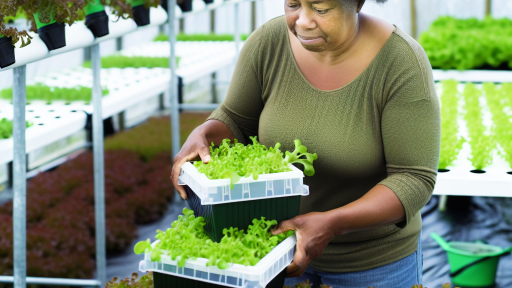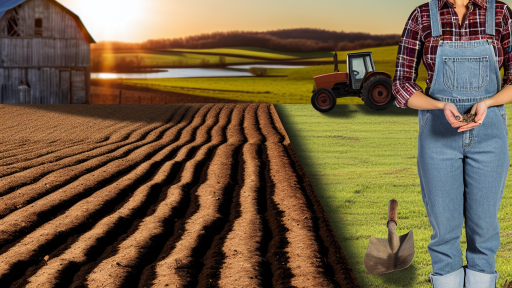Introduction to Cover Crops
Definition of Cover Crops
Cover crops are plants grown primarily to benefit soil health.
They cover the soil during off-seasons for various cash crops.
Farmers utilize these crops to prevent soil erosion and nutrient leaching.
Additionally, cover crops provide organic matter to the soil.
Importance in Agriculture
Cover crops play a crucial role in sustainable agriculture.
They enhance soil fertility by fixing nitrogen in the soil.
Moreover, they improve soil structure and water retention.
These crops also suppress weeds and reduce pest populations.
Types of Cover Crops
There are several types of cover crops suitable for various conditions.
- Legumes such as clover and vetch enrich the soil with nitrogen.
- Grasses like rye and barley improve soil structure and prevent erosion.
- Brassicas, such as radishes, enhance soil health by breaking up compacted layers.
Benefits of Cover Crops
Implementing cover crops leads to numerous long-term benefits.
Firstly, they reduce the need for synthetic fertilizers.
This practice lowers the overall cost of farming operations.
Furthermore, cover crops can enhance biodiversity on farms.
They can attract beneficial insects and other wildlife.
Challenges in Adoption
Despite their advantages, farmers face some challenges in adopting cover crops.
Transform Your Agribusiness
Unlock your farm's potential with expert advice tailored to your needs. Get actionable steps that drive real results.
Get StartedInitial costs for seeds and planting can be a barrier.
Moreover, proper management and timing are crucial for effectiveness.
Farmers may also worry about potential impacts on cash crop yields.
Successful Implementation Strategies
To ensure success, planning is essential before implementing cover crops.
Farmers should choose the right species suitable for their climate.
Additionally, they must integrate cover cropping into their overall farming practices.
Education and local outreach programs can support farmers in this transition.
Types of Cover Crops and Their Unique Benefits
Legumes
Legumes are essential cover crops for enhancing soil fertility.
They fix atmospheric nitrogen, enriching the soil naturally.
Common legumes include clover, vetch, and peas.
These crops improve soil structure and prevent erosion.
Moreover, they help suppress weeds effectively.
By adding organic matter, legumes enhance microbial activity.
Grasses
Grasses are another important category of cover crops.
They are known for their deep root systems.
These roots improve soil aeration and water infiltration.
Key grass cover crops include rye, barley, and sorghum.
Grasses help prevent soil erosion during the off-season.
Furthermore, they can contribute to biomass production.
Brassicas
Brassicas offer unique benefits as cover crops.
Crops like radishes, turnips, and mustard fall into this category.
They are excellent for breaking compacted soil layers.
Moreover, brassicas can help suppress soil-borne pests.
They also contribute valuable nutrients to the soil upon decomposition.
Showcase Your Farming Business
Publish your professional farming services profile on our blog for a one-time fee of $200 and reach a dedicated audience of farmers and agribusiness owners.
Publish Your ProfileAdditionally, they enhance biodiversity within cropping systems.
Mechanisms of Soil Fertility Enhancement
Nitrogen Fixation
Nitrogen fixation is a vital process for soil fertility.
This process involves certain plants, primarily legumes.
Legumes, like clover and soybeans, host nitrogen-fixing bacteria.
These bacteria convert atmospheric nitrogen into a usable form.
Consequently, soil gains essential nitrogen for plant growth.
Thus, intercropping legumes with other crops boosts fertility.
This practice minimizes the need for synthetic fertilizers.
Furthermore, nitrogen-rich residue improves soil nutrient content.
Organic Matter Addition
Adding organic matter significantly enhances soil health.
Organic materials include compost, green manure, and mulch.
These materials enrich soil with nutrients and improve structure.
Additionally, they increase water retention capacity.
The presence of organic matter supports beneficial microorganisms.
These microorganisms break down organic materials into plant-available nutrients.
Such processes also promote soil aeration and drainage.
As a result, organic additions are crucial for sustainable farming.
Soil Structure Improvement
Cover crops play a pivotal role in soil structure enhancement.
Their roots penetrate compacted soils, creating spaces for air and water.
This improves overall soil permeability and root development.
Additionally, cover crops reduce soil erosion from wind and water.
They protect the soil surface during fallow periods.
Moreover, a healthier soil structure supports diverse plant roots.
This supports long-term agricultural productivity and resilience.
Ultimately, improved soil structure leads to higher crop yields.
See Related Content: Organic Fertilizers: Boosting Crop Growth Naturally
Seasonal Timing: Best Practices for Planting and Terminating Cover Crops
Importance of Seasonal Timing
Seasonal timing significantly influences the effectiveness of cover crops.
Proper timing maximizes soil health and fertility.
Moreover, it impacts crop yield and diversity.
Planting Cover Crops
Choose an appropriate planting time based on local climate conditions.
Generally, plant cover crops after harvesting main crops.
This practice utilizes available sunlight and nutrients effectively.
Consider using different cover crop species for different seasons.
For instance, legumes improve nitrogen levels, while grasses reduce soil erosion.
Optimal Planting Techniques
Sow seeds at a depth suitable for the chosen species.
Ensure adequate seed-to-soil contact to promote germination.
Adopt no-till methods to minimize soil disturbance.
Utilizing a seed drill can aid in achieving proper seed placement.
Terminating Cover Crops
Terminate cover crops at the right time to enhance soil benefits.
Timing should align with the growth stage of the crop to follow.
Showcase Your Farming Business
Publish your professional farming services profile on our blog for a one-time fee of $200 and reach a dedicated audience of farmers and agribusiness owners.
Publish Your ProfileTerminate crops before they produce seeds to avoid volunteer plants.
Methods include mowing, rolling, or using herbicides.
Each method has its advantages and timing requires careful consideration.
Monitoring and Evaluation
Monitor soil health after terminating cover crops.
Look for improvements in soil structure and nutrient content.
Evaluate the impact on the subsequent crop yield for further adjustments.
Moreover, continuous assessment helps refine future practices.
You Might Also Like: Comprehensive Guide to Mulching in Crop Cultivation
Impact of Cover Crops on Soil Erosion Prevention and Water Infiltration
Role of Cover Crops in Erosion Control
Cover crops play a vital role in preventing soil erosion.
They reduce the impact of raindrops on bare soil.
Additionally, cover crops stabilize the soil with their root systems.
These plants also help in maintaining soil structure over time.
Improving Water Infiltration
Cover crops significantly enhance water infiltration in the soil.
Their roots create channels that allow water to penetrate deeply.
This process reduces surface runoff during heavy rainfall.
As a result, more water reaches the root zone of main crops.
Benefits for Agricultural Practices
Farmers experience numerous benefits from using cover crops.
They observe improved productivity in subsequent crop cycles.
This practice also leads to better nutrient cycling in the soil.
Consequently, farmers can reduce erosion risks and water wastage.
Best Practices for Implementation
Farmers should select appropriate cover crop species based on their soil type.
Diversifying cover crops can also maximize ecological benefits.
Additionally, timely planting and termination are crucial for effectiveness.
Regular monitoring ensures optimal growth and integration into the farming system.
Find Out More: Innovative Mulching Approaches for Large-Scale Farms

Economic Considerations
Cost-Benefit Analysis of Implementing Cover Crops
Cover crops offer both direct and indirect economic benefits to farmers.
Firstly, they reduce the need for chemical fertilizers.
This reduction results in cost savings for farmers.
Additionally, cover crops improve soil health and productivity.
As a result, yields can increase in subsequent cash crops.
Research shows that increased yields significantly enhance profit margins.
Moreover, these crops can decrease soil erosion and degradation.
Consequently, this preservation leads to lower long-term soil management costs.
Farmers can also benefit economically from improved water retention.
In dry seasons, cover crops enhance moisture availability for primary crops.
This moisture retention supports reliable harvests and minimizes risk.
Initial Investment vs. Long-Term Benefits
Initially, farmers may see cover crops as an added expense.
However, this investment pays off over time through various channels.
First, cover crops suppress weeds, reducing herbicide expenses.
Second, they can protect against nutrient leaching during heavy rains.
Showcase Your Farming Business
Publish your professional farming services profile on our blog for a one-time fee of $200 and reach a dedicated audience of farmers and agribusiness owners.
Publish Your ProfileIn the long run, farmers experience reduced soil amendment expenses.
Studies indicate payback periods are often less than three years.
Thus, the initial cost barrier can be viewed as a wise investment.
Evaluating Local and Market Factors
Implementation of cover crops can vary based on regional conditions.
Local climate and soil types impact the specific benefits experienced.
Additionally, market trends affect crop choices and planting strategies.
Farmers should consider consulting local agricultural experts.
They can provide insights tailored to specific regional needs.
Furthermore, farmers should look into available subsidies and grants.
Such financial aids can alleviate the costs associated with cover cropping.
Case Studies of Successful Implementation
Numerous case studies illustrate the economic advantages of cover crops.
For instance, Garcia Farms saw a 20% increase in corn yields.
This increase directly resulted from the implementation of cover crops.
Another example, Johnson Family Farm, reduced input costs by 30%.
They achieved this by minimizing fertilizer and pesticide expenses.
These success stories demonstrate the feasible economic viability of cover crops.
Ultimately, proactive investment in cover cropping methods pays dividends.
See Related Content: Optimizing Yield With Advanced Crop Analytics Tools
Case Studies: Successful Integration of Cover Crops in Different Agricultural Settings
Community Farms Adaptation
Little River Community Farm introduced cover crops to enhance soil health.
They selected clover and vetch for nitrogen fixation.
Farmers observed a significant reduction in fertilizer costs.
This practice improved crop yields the following season.
Conventional Large-Scale Farming
Green Valley Agrics has successfully integrated cover crops into their operations.
They employed rye and radishes to break compaction.
Moreover, these cover crops reduced erosion during heavy rains.
The result was healthier soil and improved water retention.
Organic Vegetable Production
Sunny Acres Organic Farm utilized cover crops to suppress weed growth.
The farm mainly used buckwheat and sorghum-sudangrass.
This strategy minimized herbicide use, promoting a healthier ecosystem.
Farmers noted an increase in beneficial insect populations.
Restoration Projects
EcoRestore implemented cover crops for land rehabilitation.
They planted native species to improve biodiversity.
This approach helped restore nutrient balance in degraded soils.
As a result, local wildlife began to flourish again.
Zero-Tillage Systems
Farms adopting zero-tillage benefited greatly from cover crops.
They grew annual ryegrass to maintain soil structure.
Subsequently, moisture levels increased during dry spells.
This practice helped farmers reduce tilling frequency.
Future Trends in Cover Crop Research
Innovations in Crop Selection
Researchers continuously explore new cover crop varieties.
These innovations enhance resilience and adaptability.
Showcase Your Farming Business
Publish your professional farming services profile on our blog for a one-time fee of $200 and reach a dedicated audience of farmers and agribusiness owners.
Publish Your ProfileNew species can provide greater nitrogen fixation.
They also contribute to improved soil structure.
Farmers gain access to detailed selection guides.
Advancements in Technology
Technology plays a crucial role in cover crop research.
Drone technology allows for precise field monitoring.
This aids in assessing cover crop health and growth.
Data analytics helps optimize planting times and methods.
Innovative apps connect farmers with research data.
Integrating Sustainable Practices
Sustainable practices foster long-term agricultural health.
Cover crops prevent soil erosion and nutrient loss.
This approach builds resilience against climate variability.
Farmers can implement regenerative farming techniques.
These practices enhance overall farm sustainability.
Collaboration Among Stakeholders
Collaboration between farmers and researchers is essential.
Joint efforts yield practical solutions for real-world challenges.
Local agricultural organizations offer valuable support.
Workshops and training sessions increase awareness.
These initiatives build community knowledge around cover crops.
Future Research Directions
Future research will focus on multi-species cover crops.
These can boost biodiversity and ecological benefits.
Additionally, studies will investigate climate-resilient crops.
This research addresses variability in weather patterns.
Farm-specific research will guide tailored solutions.
Additional Resources
Benefits of Cover Crops – SARE
Management impact and benefit of cover crops on soil quality: A …




